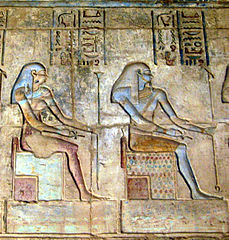
By W. M. FLINDERS PETRIE, 1906
Part 1 See here
CONTENTS
VII. THE COSMIC GODS
VIII. THE ABSTRACT GODS
IX. THE FOREIGN GODS
X. THE COSMOGONY
XI. THE RITUAL AND PRIESTHOOD
XII. THE SACRED BOOKS
XIII. PRIVATE WORSHIP
XIV. EGYPTIAN ETHICS
XV. THE INFLUENCE OF EGYPT
CHAPTER VII THE COSMIC GODS
The gods which personify the sun and sky stand apart in their essential idea from those already described, although they were largely mixed and combined with other classes of gods. So much did this mixture pervade all the later views that some writers have seen nothing but varying forms of sun-worship in Egyptian religion. It will have been noticed however in the previous chapters what a large body of theology was entirely apart from the sun-worship, while here we treat the latter as separate from the other elements with which it was more or less combined.
_Ra_ was the great sun-god, to whom every king pledged himself, by adopting on his accession a motto-title embodying the god’s name, such as _Ra-men-kau_, ‘Ra established the kas,’ Continue reading
 THE RELIGION OF ANCIENT EGYPT
THE RELIGION OF ANCIENT EGYPT Heh and Hauhet, Deities of Infinity and Eternity
Heh and Hauhet, Deities of Infinity and Eternity


 Two ivory Djed pillars found in a
Two ivory Djed pillars found in a The Djed-pillar
The Djed-pillar ,[1] is an ancient symbol for stability and endurance. It is mentioned in the Pyramid Texts of the Old Kingdom:
,[1] is an ancient symbol for stability and endurance. It is mentioned in the Pyramid Texts of the Old Kingdom: DESCRIPTION OF THE PAPYRUS OF NAS-KHEM, PRIEST OF AMEN-RA
DESCRIPTION OF THE PAPYRUS OF NAS-KHEM, PRIEST OF AMEN-RA DESCRIPTION OF THE PAPYRUS OF NAS-KHEM, PRIEST OF AMEN-RA
DESCRIPTION OF THE PAPYRUS OF NAS-KHEM, PRIEST OF AMEN-RA Book of Am-Tuat
Book of Am-Tuat
 Apep (Apophis)
Apep (Apophis)









Recent Comments